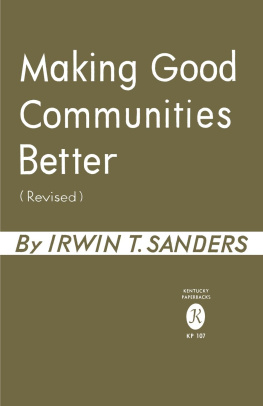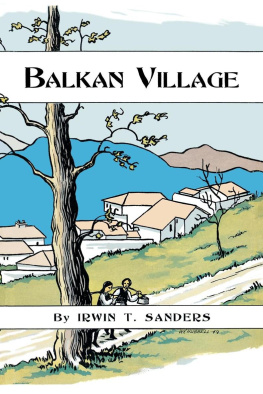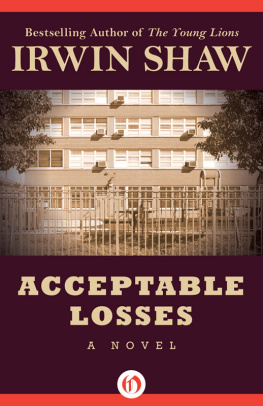MAKING GOOD
COMMUNITIES
BETTER
(REVISED)
Making Good
Communities
Better
(Revised)
By IRWIN T. SANDERS
COPYRIGHT, 1950, 1953, BY THE
UNIVERSITY OF KENTUCKY PRESS
PRINTED IN LEXINGTON AT THE
UNIVERSITY OF KENTUCKY
Library of Congress Catalog
Card Number: 52-13007
PREFACE
This Handbook Has Been Written for You
IF you are an officer or a leader of a club, society, association, or any other formal group.
IF you are aiding in any community-wide effort to reduce juvenile delinquency, promote a public health program, campaign for poultry improvementand a score of other possible projects or activities.
IF your job is the strengthening or administration of some institution such as the church, the school, government, or a business enterprise on a local, state, or national level.
IF you are a student of society and wish to learn more about the whys and wherefores of community life.
Each person using this handbook will have different questions in mind and will have had varied experiences in community activities. For that reason, the book contains a wide range of subject matter unified by a point of view which takes into account the recognized, established principles of sound community organization.
The basic principles discussed in this handbook apply to all communities, whether they are small hamlets or metropolitan centers. Techniques, however, will vary with the size of the locality.
The general tone of the handbook will impress you as being matter-of-fact. It has no axes to grind, no great inspiration to instill. The literature on the community is full of tracts, of documents with deep spiritual insight, and of article after article urging people to do this or do that if humanity is to survive. But we can assume that youthe readerare already involved in an organizational or community program, or else that you have already decided to try to get one started. You have the urge to do something, but you need some guide to help you decide where to take hold, how to do a better job.
Really a Headbook, Not a Handbook
This is really a headbook. It tells you what to think about, gives you a point of view, suggests possible solutions to problems of community organization.
This is not strictly a handbook. It gives you no pat formulas to apply everywhere under every condition. Rather, it emphasizes thinking before doing, and at times advises social patience rather than social action.
Acknowledgments
This handbook was begun during the war years in Washington, particularly while I was working for a summer with the Division of Farm Population and Rural Life of the Bureau of Agricultural Economics. Dr. Douglas Ensminger and Dr. Carl Taylor contributed greatly to its conception and to the ideas contained in it. Since that time, a number of other friends, too numerous to mention here, have made valuable criticisms which have been taken into account. Particular thanks are due those who prepared the Guideposts and thus added greatly to the practical usefulness of this handbook.
August 30, 1952IRWIN T. SANDERS, Director
Bureau of Community Service
University of Kentucky
CONTENTS
PART I
WHAT MAKES A GOOD COMMUNITY: FOUR TRAITS
WHY DO SOME communities leave a good impression with us when we drive through them, while other towns remain a dot on our road maps? All of us are attracted by well-kept lawns, wide streets, impressive public buildings, modern stores, and clean factories. If we look behind the scenes in a good community, we find a number of traits which result in an attractive, prosperous appearance. A listing of just four of these traits
1. Leaders that see the whole community,
2. A collective way of solving problems,
3. A strong sense of community loyalty, and
4. A basically stable economy
will help us considerably in understanding what makes a good community.
TRAIT
Leaders That See the Whole Community
ONE OF MY most inspiring experiences in visiting from town to town is to come upon persons, usually in good communities, who can see their city as a whole. They see one pattern after another, but they find that each pattern is a part of the total picture of their community. As they share their broad view with others, they lay a basis for sound planning and rich, satisfying experiences for those who participate in community activities.
In many good communities doubtless much is accomplished by various leaders who pursue policies of narrow self-interest. Their mistakes cancel out after a fashion, and their city is improved by their expenditure of energy. But in those communities which really get things done, the majority of leaders have learned that the welfare of their institution, business, or profession is tied in with the welfare of others, and that progress in one area which is made at the expense of others is not really community progress.
One small city affords an interesting, though simple, case of how this awareness of the whole community grows. Its leaders were suddenly concerned with a rapid increase in juvenile delinquency and got in touch with their state university for counsel and specific aid. Social scientists made a study, reported their findings to a newly organized community council, and stood by to render any further assistance that might be desired. Local leaders, however, were even ready to move ahead on their own and tackled one problem after another. On the first anniversary of the formation of this community council a local newspaper editorialized in words such as these: We have been thinking of our community only in economic terms until representatives from our state university showed us that social as well as economic factors were important in the development of sound community life.
As leaders we ought not only to see the whole community but to seek it, too. For a whole community is also a well community, in which problems are increasingly being solved, in which the citizens have a strong sense of loyalty, and in which the economy is basically stable.
TRAIT
A Collective Way of Solving Problems
EVEN GOOD communities have problems; in fact, they appear to have more problems than apathetic towns, because they tend to recognize and face up to more. But they have worked out a collective way of tackling problems. That is why good communities continue to become better.
In one community I noted considerable civic pride, but also an awareness of a big job yet to be done. When I asked some of the local people how they tackled their problems, they replied: A few of us get interested in something, talk it up among ourselves, and then try to figure out what leading citizens know most about the problem. We generally go to them, and they help get the ball rolling. Why, only last month the water in the creek outside of town got to smelling bad, and so we went to see Dr. Williams, and he got in touch with the State Health Board to see if they could help stop the pollution. It turns out that were going to have to do something drastic about sewage disposal around here, and so were having a meeting next Monday night of about twenty or thirty people to see what we had better do. And so the pattern goes, problem after problem. Someone becomes disturbed and talks to his friends; they seek out qualified leaders and then rally the support of organizations.














